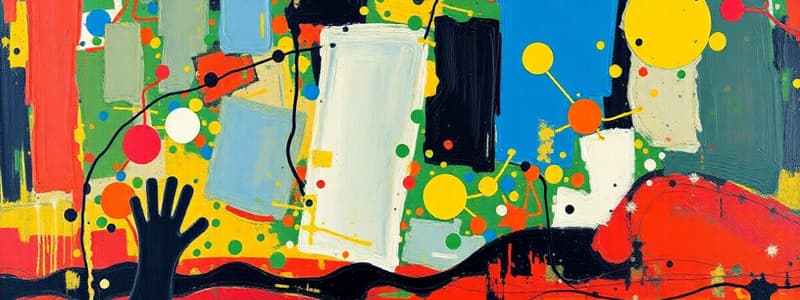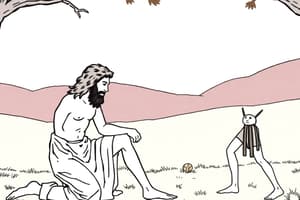Podcast
Questions and Answers
What point of view is employed in the first paragraph of Chapter 1?
What point of view is employed in the first paragraph of Chapter 1?
- Third-person limited perspective (correct)
- Second-person perspective
- First-person perspective
- Third-person omniscient perspective
Which character’s point of view is represented in Chapter 9?
Which character’s point of view is represented in Chapter 9?
- Mr. Hyde
- Dr. Lanyon (correct)
- Dr. Jekyll
- Mr. Enfield
What does the switch in points of view in the last chapters indicate?
What does the switch in points of view in the last chapters indicate?
- A transition from action to dialogue
- An emphasis on secondary characters
- A shift from humor to drama
- A focus on confession rather than narrative (correct)
What aspect of Victorian London does the text highlight?
What aspect of Victorian London does the text highlight?
In what way does Mr. Utterson's character contribute to the story?
In what way does Mr. Utterson's character contribute to the story?
What does the use of first-person point of view reveal when it is used?
What does the use of first-person point of view reveal when it is used?
What is a significant social issue highlighted in Victorian London?
What is a significant social issue highlighted in Victorian London?
Which statement best captures the atmosphere of the impoverished areas of London?
Which statement best captures the atmosphere of the impoverished areas of London?
Why did Stevenson likely choose to depict Dr. Jekyll's story primarily through Mr. Utterson's perspective?
Why did Stevenson likely choose to depict Dr. Jekyll's story primarily through Mr. Utterson's perspective?
What imagery does Stevenson use to describe the area where Mr. Hyde lives?
What imagery does Stevenson use to describe the area where Mr. Hyde lives?
What emotions does the setting evoke in Mr. Utterson as he travels through Hyde's neighborhood?
What emotions does the setting evoke in Mr. Utterson as he travels through Hyde's neighborhood?
How does the description of Mr. Utterson reflect his character?
How does the description of Mr. Utterson reflect his character?
What thematic element does Stevenson's depiction of the fog in Hyde's neighborhood highlight?
What thematic element does Stevenson's depiction of the fog in Hyde's neighborhood highlight?
Why might Stevenson emphasize the destitute communities in Victorian London?
Why might Stevenson emphasize the destitute communities in Victorian London?
What does the term 'blackguardly surroundings' suggest about Hyde's environment?
What does the term 'blackguardly surroundings' suggest about Hyde's environment?
What does the character of Mr. Utterson reveal about the nature of round characters?
What does the character of Mr. Utterson reveal about the nature of round characters?
Which detail portrays the atmosphere in Soho as unsettling?
Which detail portrays the atmosphere in Soho as unsettling?
What signifies the transformation in Dr. Jekyll's character throughout the chapters?
What signifies the transformation in Dr. Jekyll's character throughout the chapters?
What is an allusion?
What is an allusion?
In Stevenson's narrative, what is the heresy that Utterson references?
In Stevenson's narrative, what is the heresy that Utterson references?
What philosophical question does Stevenson raise through Utterson's viewpoint?
What philosophical question does Stevenson raise through Utterson's viewpoint?
What point of view is primarily used by Stevenson in the storytelling?
What point of view is primarily used by Stevenson in the storytelling?
What does Utterson’s role suggest about his influence on others?
What does Utterson’s role suggest about his influence on others?
What is the potential consequence of telling the hard truth to someone in trouble, as discussed in the narrative?
What is the potential consequence of telling the hard truth to someone in trouble, as discussed in the narrative?
Which biblical story does Dr. Jekyll allude to in Chapter 10?
Which biblical story does Dr. Jekyll allude to in Chapter 10?
Flashcards
What is an allusion?
What is an allusion?
A brief and indirect reference to a person, place, thing or idea of historical, cultural, literary or political significance. It is a literary device that can add depth and richness to a text by suggesting a connection to something outside of the text itself.
Cain's heresy
Cain's heresy
A philosophy or belief that emphasizes individual responsibility and freedom, suggesting that one should not interfere in the choices and actions of others, even if those choices seem harmful or misguided.
Third-person limited point of view
Third-person limited point of view
A narrative perspective where the story is told from the viewpoint of an outside observer who can only see and know what one character is thinking and feeling. The narrator's knowledge is limited to that of the chosen character.
Multiple points of view
Multiple points of view
Signup and view all the flashcards
First-person point of view
First-person point of view
Signup and view all the flashcards
Third-person omniscient point of view
Third-person omniscient point of view
Signup and view all the flashcards
Point of View
Point of View
Signup and view all the flashcards
Third Person Limited
Third Person Limited
Signup and view all the flashcards
First Person
First Person
Signup and view all the flashcards
Impact of Point of View
Impact of Point of View
Signup and view all the flashcards
Setting
Setting
Signup and view all the flashcards
Atmosphere
Atmosphere
Signup and view all the flashcards
Historical Period
Historical Period
Signup and view all the flashcards
Characterization
Characterization
Signup and view all the flashcards
Soho
Soho
Signup and view all the flashcards
Round Character
Round Character
Signup and view all the flashcards
Flat Character
Flat Character
Signup and view all the flashcards
Protagonist
Protagonist
Signup and view all the flashcards
Static Character
Static Character
Signup and view all the flashcards
Dynamic Character
Dynamic Character
Signup and view all the flashcards
Setting as a Revelation of Character
Setting as a Revelation of Character
Signup and view all the flashcards
Mr. Utterson's Complex Character
Mr. Utterson's Complex Character
Signup and view all the flashcards
Good vs. Evil: A Reoccurring Theme
Good vs. Evil: A Reoccurring Theme
Signup and view all the flashcards
Study Notes
Allusions in "Cain's Heresy"
- An allusion is a passing reference to history or literature.
- In The Strange Case of Dr. Jekyll and Mr. Hyde, Stevenson uses a biblical allusion to Cain and Abel.
- Cain's "heresy" is defined as neglecting the well-being of loved ones, refusing to be a "keeper" to them.
Point of View
- The story is primarily told from a third-person limited point of view, focusing on Utterson's thoughts and feelings.
- Some sections shift to first-person, such as from Enfield's perspective or from Jekyll's confession.
- This shift in perspective enhances the narrative.
Victorian London Setting
- Victorian London was changing from a troubled past to growing wealth and prosperity.
- Wealthy Londoners enjoyed culture, parties, and high society, contrasting with the poor and impoverished communities in the slums.
- London's poor faced harsh living conditions, including homelessness, rising slums, and sanitation problems which led to widespread disease.
- Poverty was substantial, with large populations of Irish immigrants, Jewish refugees, and others from oppressed Eastern European countries seeking opportunity.
- Crime flourished in the face of police corruption, with neighborhoods like Whitechapel affected by prostitution and the notorious Jack the Ripper.
Characterization
- Stevenson uses setting to showcase character.
- Mr. Hyde's residence in a foggy, dismal district foreshadows his darkness and tendency for hiding the truth.
- The description of the Soho district provides a sense of foreboding to both the characters and the reader.
- Mr. Utterson is a complex, or round, character showing contradictions in his personality.
Round and Flat Characters
- Round characters have complex personalities, with varied motivations and values.
- Flat characters have simple, one-note personalities.
- Mr. Hyde is a flat character, portrayed as cruel and lacking complexity.
- Mr. Utterson is a round character, demonstrated by his conflicting motivations towards Jekyll.
The Story's Crisis
- The crisis in The Strange Case of Dr. Jekyll and Mr. Hyde is the turning point in Chapter 8.
- At the turning point, characters come together to face the threat.
- The rising actions—including Lanyon's death, the murder of Sir Danvers Carew, and the window incident—culminate in the crisis/turning point of Jekyll and Hyde.
- The finding of Hyde's dead body signifies that the main antagonist is defeated.
Studying That Suits You
Use AI to generate personalized quizzes and flashcards to suit your learning preferences.




